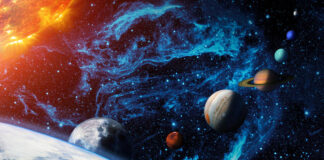MAY 7, 2018

We all know stars age and die over a course of several billion years. Our sun is expected to meet its fate in some 10 billion years, but what might happen after those final moments has always been a point of debate.
As we won’t be around to see the remains of our star, an international team of astronomers has predicted how the central hub of the solar system might change during after its death. They used a novel stellar, data-model and came to the conclusion that following its death, our sun will turn into a giant ring, one made up of an extremely bright envelope of interstellar gas and dust.
In astronomical terms, a ring like this is called a planetary nebula. It marks the end of stellar lives in 90 percent of cases, but until now scientists were not sure if something similar might happen to our sun, as well.
Scientists reveal our sun might turn into a planetary nebula after drying. Pictured, Abell 39, the 39th entry in a catalog of large nebulae discovered by George Abell in 1966, is a beautiful example of a planetary nebula.
“When a star dies, it ejects a mass of gas and dust – known as its envelope – into space. The envelope can be as much as half the star’s mass,” Albert Zijlstra, a member of the team, said in a statement while describing the ring formation process. “This reveals the star’s core, which by this point in the star’s life is running out of fuel, eventually turning off and before finally dying.”
Due to the hot core, the ejected ring shines brightly for almost ten thousand years, making the planetary nebula visible.
“Some are so bright that they can be seen from extremely large distances measuring tens of millions of light years, where the star itself would have been much too faint to see,” Zijlstra added.
Older scientific models said our star didn’t have enough mass to produce a visible nebula, but observational data suggested otherwise. This led to a major debate for more than two decades.
“The data said you could get bright planetary nebulae from low mass stars like the sun, [while] the models said that was not possible, anything less than about twice the mass of the sun would give a planetary nebula too faint to see.”
However, the latest scientific model, which scientists used with stellar mass and age to predict how bright the ejected envelop would shine in space, solved the problem. It revealed in the wake of the ejection the star heats up three times faster than what has been noted in the previous models. This contributes luminosity, making the nebula visible, despite the low mass.
The work also revealed that our Sun is just as big as the lowest mass star that could produce a visible planetary nebula. “This is a nice result,” Zijlstra concluded. “Not only do we now have a way to measure the presence of stars of ages a few billion years in distant galaxies, which is a range that is remarkably difficult to measure, we even have found out what the sun will do when it dies!”
Courtesy/Source: The study was published in the journal Nature Astronomy on May 7.










































































































